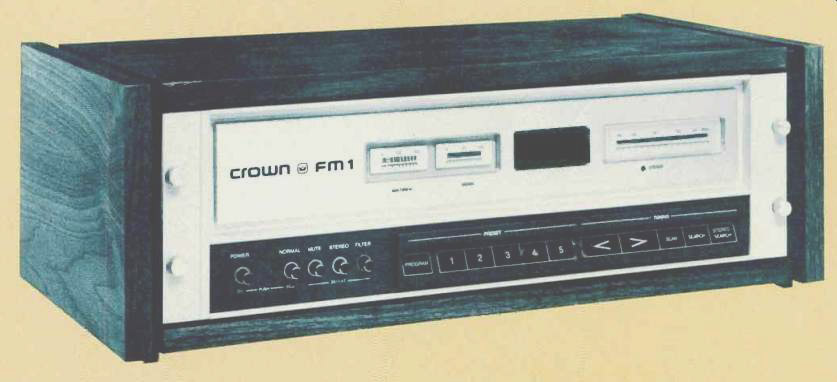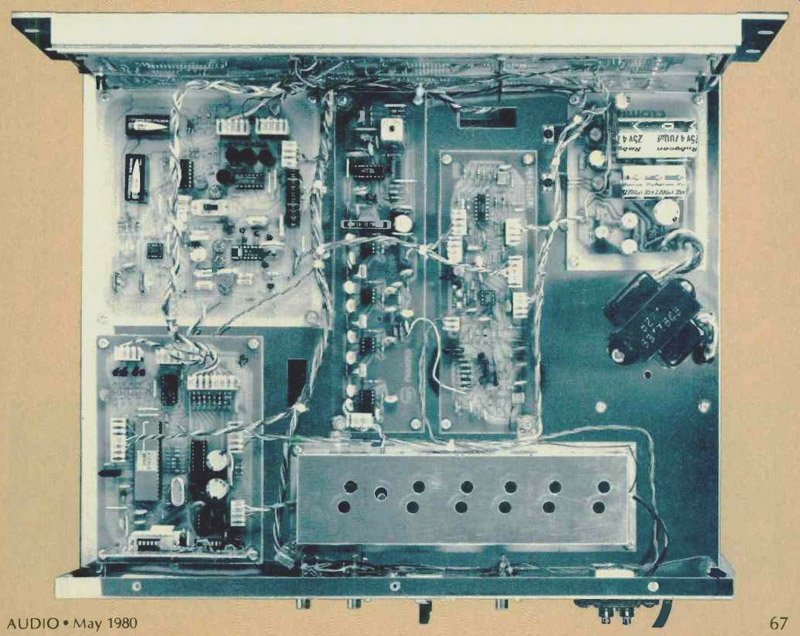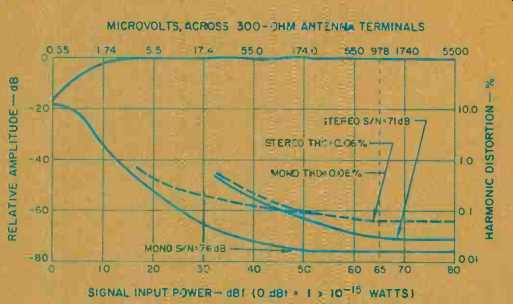
Manufacturer's Specifications:
Mono Usable Sensitivity: 10.8 dBf (1.9 uV).
50-db Quieting Sensitivity: Mono, 14 dBf (2.75uV); stereo, 36.1 dBf (35 uV).
S/N at 65 dBt Mono, 70 dB; stereo, 65 dB.
THD at 1 kHz: Mono, 0.1 percent; stereo, 0.09 percent.
Capture Ratio: 2.0 dB.
Alternate Channel Selectivity: 75 dB.
Stereo Separation: 45 dB at 1 kHz, 35 dB at 10 kHz.
General Specifications
Weight: 15 1/2 lbs. (7 kg).
Price: $995.00.
Crown International of Elkhart, Indiana, long renowned for their high-quality amplifier and preamplifier products, has finally come up with an FM tuner designed to match and complement their other high-end audio products. The Model FM-1 looks distinctively different from any other tuner we have ever seen. As you might expect, in these days of digital readout audio equipment, the conventional flywheel and dial-string have been replaced by a quartz-crystal referenced LSI digital controller. In deference to the traditionalists who insist upon seeing where they are on the FM dial, an analog frequency reference band, composed of a series of LED indicators, is located to the right of the purely digital frequency readout. These LEDs, 20 in all, simply flash to indicate the nearest MHz to which the unit is tuned.

Additional LED displays to the left of the frequency readout area are used to indicate multipath reception and signal strength. Unlike the usual mechanical signal-strength meter found on many tuners and receivers, the LEDs of the signal-strength indicator display on the Crown FM-7 have been calibrated to provide meaningful indications of signal strength. Specifically, on the sample tuner we tested, illumination of successive LEDs occurred at the following levels of input signal at the antenna terminals: 31 dBf, 35 dBf, 40 dBf, 45 dBf, 51 dBf, 55 dBf, 62 dBf, 75 dBf, and 85 dBf. The multi-path-indicating LEDs show the amount of multipath interference being received, so that a minimum or no indication on this bank of LEDs is to be sought when orienting any FM antenna connected to the FM-1.
Five push buttons at the lower left of the front panel handle power turn-on, selection of 25- or 75- uS de-emphasis, FM muting, stereo/mono selection, and high-blend filtering.
The action of this last button is somewhat unexpected since what we feel to be the normal position, where the filter is defeated, is the depressed position. We usually assume the "out" position to be the normal one.
All of the remaining functions of the FM-1 are controlled by touch-button surfaces along the lower edge of the panel, which is gently sloped upward for easy finger access. A Pro gram button and five preset touch switches are used to store five favorite station frequencies in the tuner's "memory." To program the unit, one simply tunes to the desired frequency, touches the program button and then touches one of the five numbered buttons. To recall the frequency memorized, it is then simply necessary to touch the appropriate numbered button. A pair of arrow-marked segments of the switching area are used to tune the FM-1. By repeatedly touching and releasing one of these segments, the tuner will tune in 200 kHz increments. By pressing and holding either the Up or Down button, continuous scanning of the entire FM band takes place, enabling you to reach a desired frequency more quickly.
Tapping the Scan segment switch causes the tuner to scan the FM band until it finds a signal it can lock onto. Once locked in, the unit will allow you to sample the program material being broadcast for approximately seven seconds. If you hear something you like, you simply touch the Scan segment again. Otherwise, the FM-1 will scan to the next usable signal and repeat the process until you give it a command to stop scanning.
By touching the Search segment switch, the FM-1 will search up or down the FM band until it comes across a signal whose strength is great enough to overcome the mute threshold level. When the FM-1 locks onto a signal in the search mode, it will remain tuned to that signal until another command has been entered. Finally, the Stereo Search switch segment initiates the same sort of band searching as does the Search button, except that the search operation will only stop when stereo signals of adequate strength are encountered. Interestingly, if you push the Mono/Stereo switch so that it is in the mono mode and then touch the Stereo Search segment, the tuner will continue to search, endlessly, until you cancel the command, since it cannot intercept a stereo signal under those conditions.
If the a.c. current goes off or if the unit is unplugged, and then normal supply of power goes on again, the digital readout will display the frequency of (and the tuner will be tuned to) the signal last listened to before the power interruption.
There are two sets of output jacks on the rear panel of the FM-1. Both deliver the same signal, but the signals available at the "variable" jacks are controllable in level by means of potentiometers from around 160 uV to 0.9 V. Another control on the rear panel is used for adjusting mute threshold level, while additional rear panel jacks permit connection to an oscilloscope for visual display of multipath.
Six double-varactor diodes are used in the front end of the FM-1, instead of the conventional mechanically tuned variable capacitor. A combination of three linear-phase ceramic filters, followed by a single SAW filter, are used in the FM i.f. section of the tuner. The memory system of the tuner uses an electronically alterable ROM which insures memory retention of selected frequencies even after the power is turned off.
In addition to using the FM-1 as it comes, adaptor hard ware consisting of "mounting ears" and the required bolts are supplied for mounting the unit in a standard 19-in. rack.
Alternatively, Crown has available an optional hardwood cabinet into which the FM-1 can be installed.
Laboratory Measurements

Fig. 1--Mono and Stereo quieting and distortion characteristics.
Usable sensitivity in mono measured 10.7 dBf (1.9 uV) as claimed. Stereo switching threshold was set a bit higher than we would like to see, which limited stereo usable sensitivity to 31.6 dBf (21 uV). Fifty-dB quieting sensitivity measured 14.7 dBf (3.0 uV) in mono and a very satisfactory 34.7 dBf (30 uV) in stereo. Best signal-to-noise in mono and stereo, for 65 dBf input signal strength, measured 76 dB and 71 dB respectively. Clearly, the advantages gained through varactor tuning (programmability, frequency synthesis, etc.) are still offset, in part, by signal-to-noise considerations, though the figures obtained for the FM-1 are adequate in most listening situations.

Fig. 2--Frequency response and stereo separation.
Fig. 3--Separation vs. frequency with the blend filter on.
Fig. 4--Crosstalk components for 5-kHz modulating signal.
The quieting and distortion characteristics of the FM-1 are shown in the graphs of Fig. 1. Harmonic distortion for mono, with a 1-kHz modulating signal, reached a low of 0.06 percent; the same low level of distortion was obtained in stereo.
At the other standard test frequencies, distortion in mono remained quite low, with readings of 0.1 percent at 100 Hz and 0.15 percent at 6 kHz. In stereo, THD measured 0.25 percent at 100 Hz and 0.33 percent at 6 kHz. Capture ratio, at 65 dBf, measured 1.8 dB, a bit better than the 2.0 specification. Alternate channel selectivity measured 83 dB, an excellent value for a tuner which is not equipped with variable i.f. bandwidth facilities, while spurious response rejection measured 76 dB.
Frequency response in both the stereo and mono modes was extremely flat, as can be seen from the upper trace of Fig. 2. Deviation from flat response was no greater than ±0.5 dB from 30 Hz all the way to the 15-kHz extreme. The lower curve of Fig. 2 represents stereo separation (each vertical di vision in the display is 10 dB of amplitude), and it is interesting to note that there was very little loss of separation at the frequency extremes compared with separation at 1 kHz. Specifically, we measured 50 dB of separation at 100 hz and 1 kHz, and 45 dB at 10 kHz. Excellent performance! Figure 3 illustrates what happens when the stereo filter is activated. The designers of the FM-1 have chosen to intro duce an extreme amount of blend to reduce weak-signal stereo noise and distortion; so much so that when this feature is used, there is very little separation remaining above 2 kHz or so.
Figure 4 illustrates the nature of the crosstalk observed in the unmodulated channel output of the tuner when a 5-kHz signal is used to modulate the opposite channel to a level of 100 percent. The spectrum analyzer was swept linearly this time (5 kHz per horizontal division) and vertical amplitude is still 10 dB per division. The tall spike at left represents the desired output from the modulated channel-output terminal.
The shorter spike, contained within the tall one, is the actual 5-kHz crosstalk observed in the opposite channel, while the additional spikes to the right represent distortion components in the crosstalk signal, 19-kHz pilot-carrier component and, at the right of the display, minute amounts of 38-kHz and other subcarrier harmonic components.
Use and Listening Tests
The Crown FM-1 is certainly an easy tuner to use, and one which assures minimum-distortion tuning and complete freedom from drift. Externally, it offers a degree of elegance which is totally consistent with that offered by other Crown audio products. As for sound quality and reception capability, the FM-1 will in most every case be limited by the quality and strength of the signal from the FM station, rather than its own abilities. There is sufficient range of mute threshold control to take care of virtually all listening situations, though as we mentioned earlier, we would have preferred a lower stereo threshold switching point in view of the fast quieting characteristics of the tuner.
Evaluating the FM-1 simply in terms of dollars per dB or NV will not tell the whole story of this tuner. While it will certainly perform with most every unit on the market today, the host of convenience and tuning accuracy features must also be taken into account. If one is going to go beyond good basic performance and desires a tuner with such niceties as digital readout, signal locking, memory recall of stations even after power failures, touch selection of station search, etc., then the near-$1,000 price tag of this American-made tuner will be seen to be much more reasonable. It's a matter of paying your money and taking your choice, and whoever said features and quality came cheap.
-Leonard Feldman
(Audio magazine, May 1980)
Also see:
Crown Model DL-2 Digilogic Control Center (Equipment Profile, Mar. 1979)
= = = =